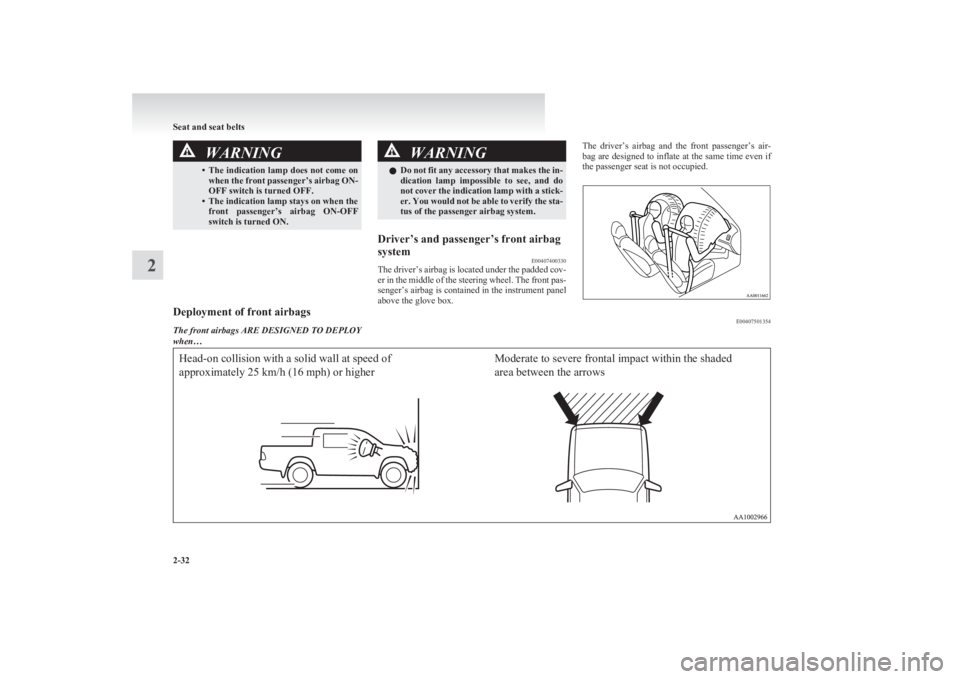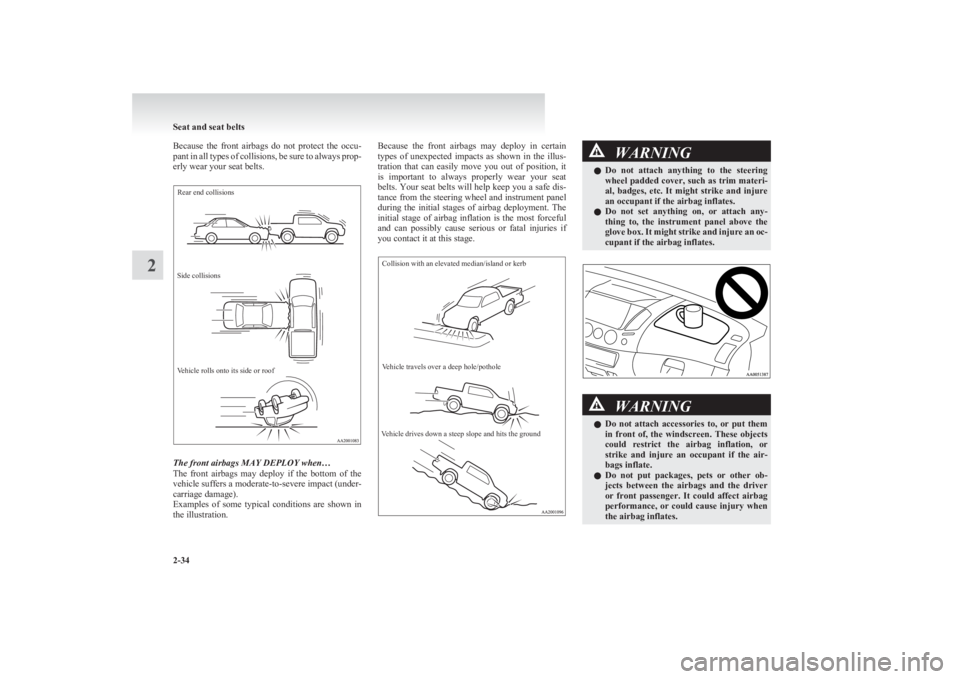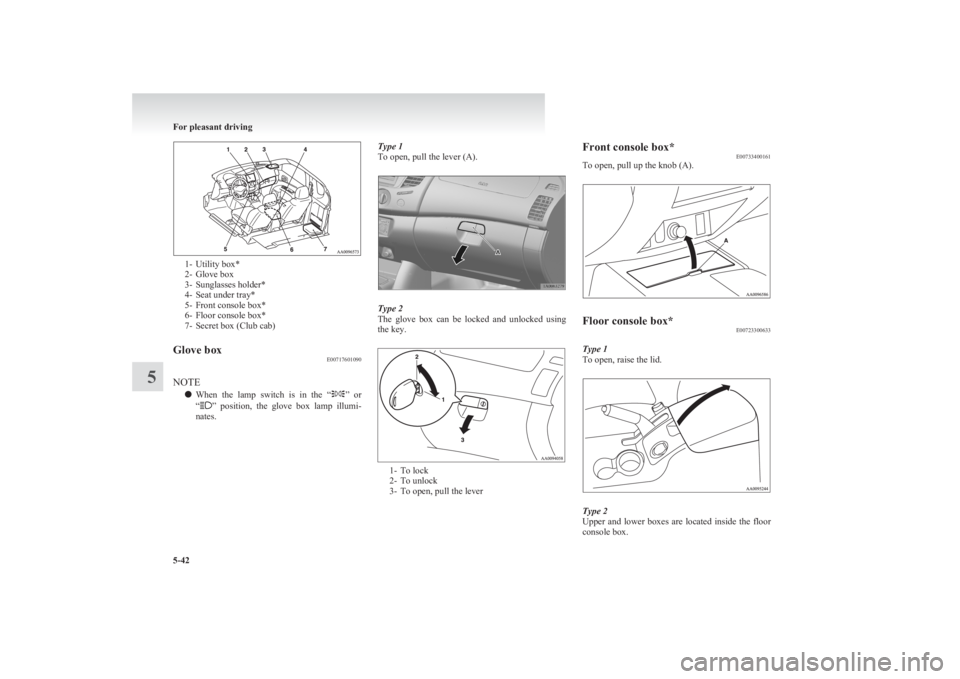2011 MITSUBISHI L200 glove box
[x] Cancel search: glove boxPage 6 of 330

Instruments and Controls (Single cab)E001001045771. Hazard warning flasher switch p. 3-34
2. Heater/Manual air conditioning* p. 5-03
3. Rear window demister switch p. 3-40
4. Utility box p. 5-43
5. Ventilators p. 5-02
6. Supplemental restraint system (SRS) - airbag (for front passen- ger’s seat) p. 2-27
7. Front passenger’s airbag OFF indication lamp p. 2-31
8. Glove box p. 5-42 Front passenger’s airbag ON-OFF switch p. 2-30
9. Cigarette lighter p. 5-37
10. Gearshift lever p. 4-14
11. Transfer shift lever (4WD only) p. 4-20
12. Cup holder* p. 5-44
13. Parking brake lever Type 1* p. 4-07
14. Parking brake lever Type 2* p. 4-07
15. Ashtray p. 5-36
Overview12
3
4
5
6
78
9
10
11
12
13
14 15
LHD
Page 7 of 330

1. Supplemental restraint system (SRS) - airbag (for front passen-ger’s seat) p. 2-27
2. Ventilators p. 5-02
3. Utility box p. 5-43
4. Rear window demister switch p. 3-40
5. Heater/Manual air conditioning* p. 5-03
6. Hazard warning flasher switch p. 3-34
7. Cigarette lighter p. 5-37
8. Parking brake lever Type 2* p. 4-07
9. Parking brake lever Type 1* p. 4-07
10. Cup holder* p. 5-44
11. Transfer shift lever (4WD only) p. 4-20
12. Gearshift lever p. 4-14
13. Ashtray p. 5-36
14. Glove box p. 5-42 Front passenger’s airbag ON-OFF switch p. 2-30
15. Front passenger’s airbag OFF indication lamp p. 2-31
Overview12
3
4
5
6
7
8
9
10
11
12
13
14
15
RHD
Page 8 of 330

Instruments and Controls (Club, Double cab)E001001045801. Hazard warning flasher switch p. 3-34
2. Heater/Manual air conditioning* p. 5-03 Automatic air conditioning* p. 5-08
3. Rear window demister switch (vehicle with heater/manual air con-
ditioning) p. 3-40
4. Utility box* p. 5-43 Centre information display* p. 3-10
MITSUBISHI Multi-Communication System*
Refer to the separate “MITSUBISHI Multi-Communication Sys-
tem owner’s manual”
5. Ventilators p. 5-02
6. Supplemental restraint system (SRS) - airbag (for front passen- ger’s seat) p. 2-27
7. Front passenger’s airbag OFF indication lamp p. 2-31
8. Glove box p. 5-42 Front passenger’s airbag ON-OFF switch p. 2-30
9. Ashtray (fixed position)* p. 5-36
10. Cigarette lighter p. 5-37
11. Rear retractable power window switch* p. 1-08
12. Transfer shift lever (4WD only) p. 4-25, 4-29
13. Parking brake lever p. 4-07
14. Cup holder p. 5-44
15. Ashtray (moveable)* p. 5-36
16. Front console box* p. 5-42
17. Heated seat switch* p. 2-06
18. Gearshift lever* p. 4-14 Selector lever* p. 4-16, 4-20
19. Audio* p. 5-13
OverviewLHD1 2
3
4
56
7
8
9
10
11
12
13
14 15 16
17 18
19
Page 9 of 330

1. Supplemental restraint system (SRS) - airbag (for front passen-ger’s seat) p. 2-27
2. Ventilators p. 5-02
3. Utility box* p. 5-43 Centre information display* p. 3-10
MITSUBISHI Multi-Communication System*
Refer to the separate “MITSUBISHI Multi-Communication Sys-
tem owner’s manual”
4. Rear window demister switch (vehicle with heater/manual air con-
ditioning) p. 3-40
5. Heater/Manual air conditioning* p. 5-03 Automatic air conditioning* p. 5-08
6. Hazard warning flasher switch p. 3-34
7. Audio* p. 5-13
8. Transfer shift lever (4WD only) p. 4-25, 4-29
9. Heated seat switch* p. 2-06
10. Parking brake lever p. 4-07
11. Cup holder p. 5-44
12. Ashtray (moveable)* p. 5-36
13. Gearshift lever* p. 4-14 Selector lever* p. 4-16, 4-20
14. Front console box* p. 5-42
15. Cigarette lighter p. 5-37
16. Rear retractable power window switch* p. 1-08
17. Glove box p. 5-42 Front passenger’s airbag ON-OFF switch p. 2-30
18. Front passenger’s airbag OFF indication lamp p. 2-31
OverviewRHD12
3
4
5
6
7
8 9 10
11
12
13
14
15 16
17
18
Page 76 of 330

The airbags will operate only when the ignition
switch is in the “ON” or “START” position.
When the airbag control unit detect an impact of suf-
ficient frontal or side force, it sends an ignition sig-
nal to the airbag modules to ignite materials in the
inflator and generate gas and inflate the airbags.
The airbags deployment produces a sudden, loud
noise, and releases some smoke and powder, but
these conditions are not injurious, and do not indi-
cate a fire in the vehicle. People with respiratory
problems may feel some temporary irritation from
chemicals used to produce the deployment; open
the windows after airbag deployment, if safe to do
so.
The airbags deflate very rapidly after deployment,
so there is little danger of obscured vision.
The time required from the sensors detecting an im-
pact to deflation of the airbags after deployment is
shorter than a blink of an eye.CAUTIONl Airbags inflate at an extremely rapid
speed. In certain situations, contact with
inflating airbags can result in abrasions,
light cuts, bruises, and the like.Front passenger’s airbag ON-OFF
switch E00410100184
The front passenger’s airbag ON-OFF switch can
be used to disable the front passenger’s airbag. If
you have a rearward facing child restraint system
that cannot be fitted to any seat other than the front
passenger seat, be sure to turn OFF the front passen-
ger’s airbag ON-OFF switch before using it. (Refer
to “To turn an airbag off” on page 2-30.)
The front passenger’s airbag ON-OFF switch is lo-
cated in the glove box.WARNINGl To reduce risk of serious or fatal injury:
•Always remove the key from the igni-
tion switch before operating a front
passenger’s airbag ON-OFF switch.
Failure to do so could adversely affect
the airbag performance.
• Wait at least 60 seconds to operate the
front passenger’s airbag ON-OFF
switch after turning the ignition
switch from “ON” position to
“LOCK” position.
The SRS airbag system is designed to
retain enough voltage to deploy the air-
bag.WARNING• Always remove the key from the front
passenger’s airbag ON-OFF switch af-
ter operating that switch. Failure to
do so could lead to improper position
of the front passenger’s airbag ON-
OFF switch.To turn an airbag off E00410600219
To turn an airbag off, follow these steps:
1.Insert the key into the key opening of the ap-
propriate front passenger’s airbag ON-OFF
switch, and turn that airbag ON-OFF switch
to the “OFF” position.
2. Remove the key from the key opening of the
front passenger’s airbag ON-OFF switch.
3. Insert the key into the ignition switch, and
turn the ignition to the “ON” position.
The front passenger’s airbag OFF indication lamp
will stay on to show that the front passenger’s air-
bag is not operational. ( “Front passenger’s airbag
OFF indication lamp” on page 2-31)
Seat and seat belts
2-30
2
Page 78 of 330

WARNING•The indication lamp does not come on
when the front passenger’s airbag ON-
OFF switch is turned OFF.
• The indication lamp stays on when the front passenger’s airbag ON-OFF
switch is turned ON.WARNINGl Do not fit any accessory that makes the in-
dication lamp impossible to see, and do
not cover the indication lamp with a stick-
er. You would not be able to verify the sta-
tus of the passenger airbag system.Driver’s and passenger’s front airbag
system E00407400330
The driver’s airbag is located under the padded cov-
er in the middle of the steering wheel. The front pas-
senger’s airbag is contained in the instrument panel
above the glove box.
The driver’s airbag and the front passenger’s air-
bag are designed to inflate at the same time even if
the passenger seat is not occupied.Deployment of front airbags E00407501354The front airbags ARE DESIGNED TO DEPLOY
when…Head-on collision with a solid wall at speed of
approximately 25 km/h (16 mph) or higher Moderate to severe frontal impact within the shaded
area between the arrows
Seat and seat belts
2-32
2
Page 80 of 330

Because the front airbags do not protect the occu-
pant in all types of collisions, be sure to always prop-
erly wear your seat belts.Rear end collisionsSide collisionsVehicle rolls onto its side or roof
The front airbags MAY DEPLOY when…
The front airbags may deploy if the bottom of the
vehicle suffers a moderate-to-severe impact (under-
carriage damage).
Examples of some typical conditions are shown in
the illustration.
Because the front airbags may deploy in certain
types of unexpected impacts as shown in the illus-
tration that can easily move you out of position, it
is important to always properly wear your seat
belts. Your seat belts will help keep you a safe dis-
tance from the steering wheel and instrument panel
during the initial stages of airbag deployment. The
initial stage of airbag inflation is the most forceful
and can possibly cause serious or fatal injuries if
you contact it at this stage.Collision with an elevated median/island or kerbVehicle travels over a deep hole/potholeVehicle drives down a steep slope and hits the ground
WARNINGl Do not attach anything to the steering
wheel padded cover, such as trim materi-
al, badges, etc. It might strike and injure
an occupant if the airbag inflates.
l Do not set anything on, or attach any-
thing to, the instrument panel above the
glove box. It might strike and injure an oc-
cupant if the airbag inflates.WARNINGl Do not attach accessories to, or put them
in front of, the windscreen. These objects
could restrict the airbag inflation, or
strike and injure an occupant if the air-
bags inflate.
l Do not put packages, pets or other ob-
jects between the airbags and the driver
or front passenger. It could affect airbag
performance, or could cause injury when
the airbag inflates.
Seat and seat belts
2-34
2
Page 224 of 330

1- Utility box*
2- Glove box
3- Sunglasses holder*
4- Seat under tray*
5- Front console box*
6- Floor console box*
7- Secret box (Club cab)
Glove box E00717601090
NOTE
l When the lamp switch is in the “
”
or
“” position, the glove box lamp illumi-
nates.
Type 1
To open, pull the lever (A).
Type 2
The glove box can be locked and unlocked using
the key.
1- To lock
2- To unlock
3- To open, pull the lever
Front console box* E00733400161
To open, pull up the knob (A).Floor console box* E00723300633
Type 1
To open, raise the lid.
Type 2
Upper and lower boxes are located inside the floor
console box.
For pleasant driving
5-42
5